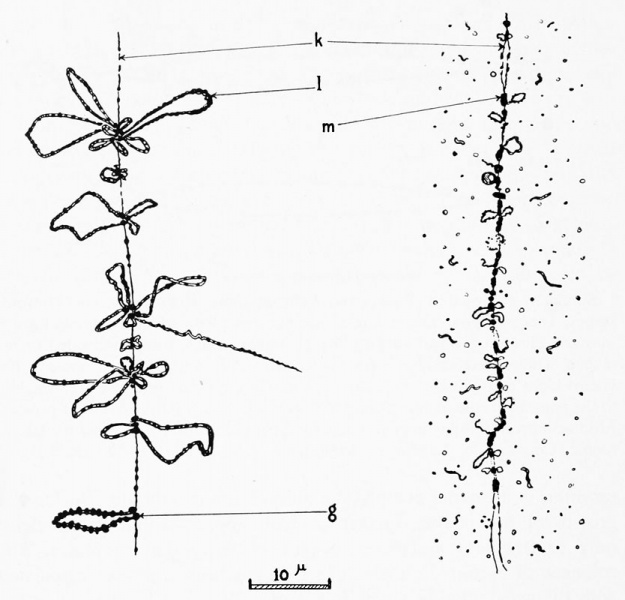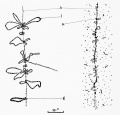File:Rugh 041.jpg

Original file (834 × 800 pixels, file size: 73 KB, MIME type: image/jpeg)
Lateral loops of the amphibian chromosome
The lateral loops originate from chromosomal granules and the lateral branches are not homogeneous in structure, but are made up of smaller particles embedded in a hyaline cylinder. These lateral loops occur in separable clusters of 1 to 9 loops along a single chromonema. These loops reach their greatest development at stage 4, when the chromosome frame is most expanded. They average 9.5 microns in length but may reach 24 microns. They are not resorbed back into the chromosome and the number of loops per chromosome decreases with time, although the number of chromomeres per chromosome remains constant.
Reference
Courtesy, W. R. Duryee, 1950, Ann. N. Y. Acad. ScL, 50, Art. 8.
| Historic Disclaimer - information about historic embryology pages |
|---|
| Pages where the terms "Historic" (textbooks, papers, people, recommendations) appear on this site, and sections within pages where this disclaimer appears, indicate that the content and scientific understanding are specific to the time of publication. This means that while some scientific descriptions are still accurate, the terminology and interpretation of the developmental mechanisms reflect the understanding at the time of original publication and those of the preceding periods, these terms, interpretations and recommendations may not reflect our current scientific understanding. (More? Embryology History | Historic Embryology Papers) |
Reference
Rugh R. Book - The Frog Its Reproduction and Development. (1951) The Blakiston Company.
Cite this page: Hill, M.A. (2024, April 20) Embryology Rugh 041.jpg. Retrieved from https://embryology.med.unsw.edu.au/embryology/index.php/File:Rugh_041.jpg
- © Dr Mark Hill 2024, UNSW Embryology ISBN: 978 0 7334 2609 4 - UNSW CRICOS Provider Code No. 00098G
File history
Click on a date/time to view the file as it appeared at that time.
| Date/Time | Thumbnail | Dimensions | User | Comment | |
|---|---|---|---|---|---|
| current | 09:00, 12 April 2013 |  | 834 × 800 (73 KB) | Z8600021 (talk | contribs) | ==Lateral loops of the amphibian chromosome== The lateral loops originate from chromosomal granules and the lateral branches are not homogeneous in structure, but are made up of smaller particles embedded in a hyaline cylinder. These lateral loops occ... |
You cannot overwrite this file.
File usage
The following 2 pages use this file:
